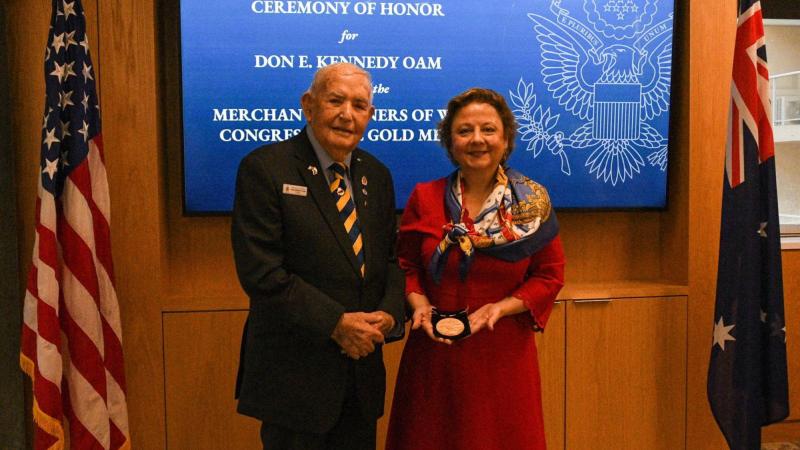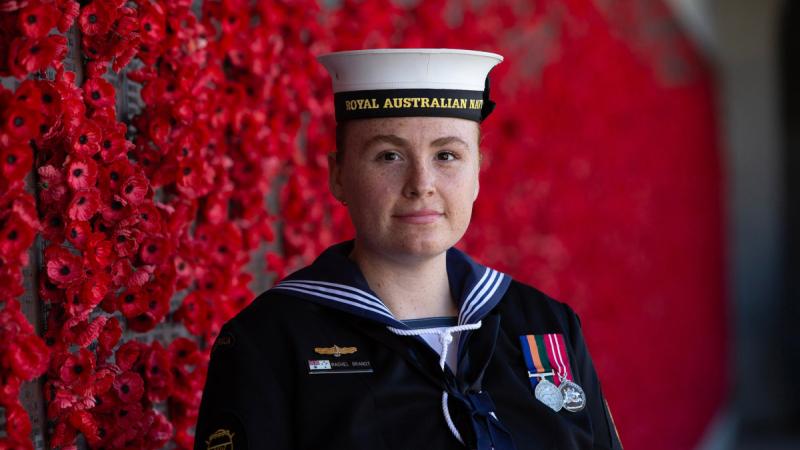At a high-security lab at UNSW Sydney, scientists are working around the clock to develop treatments and therapies to manage COVID-19. Here’s what their days look like.
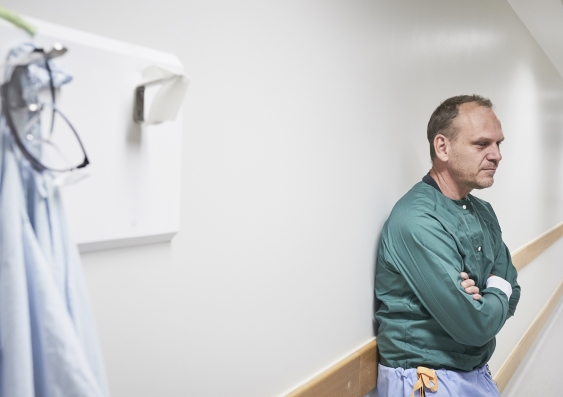
Stuart Turville in the Kirby Institute’s Glendonbrook laboratories, before getting dressed in full PPE to enter the PC3 lab. Image: Richard Freeman / UNSW.
Associate Professor Stuart Turville is one of the many scientists who dropped everything in response to the COVID-19 pandemic.
His office is the level three physical containment (PC3) lab at UNSW Medicine’s Kirby Institute. He was working in the lab researching HIV transmission and gene therapy vectors in February – what he says already feels like a lifetime ago.
“Two months ago, we needed to kick everyone out of the lab,” he says.
“As HIV is a blood-borne virus, the lab had been built with blood contaminants in mind – sharp objects and cuts were the main safety concerns.
“But we needed a different set of containment procedures to manage the respiratory-borne virus SARS-CoV-2.”
The lab was quickly retrofitted and is now fully equipped to study the live SARS-CoV-2 virus. It has opened its doors to collaborators from UNSW Medicine’s School of Medical Sciences, Prince of Wales Hospital and the Garvan Institute.
Together, the scientists are working on creating treatments and therapies to use against COVID-19.
A/Prof Turville hopes they can work quickly enough to save lives.
“I’ve got an 80-year-old father with heart problem at home. My mother is in her 70s,” he says.
“If they ever get sick, I want to make sure that there’s a therapy that would keep them – and other families out there – safe.”
Dressing for the occasion
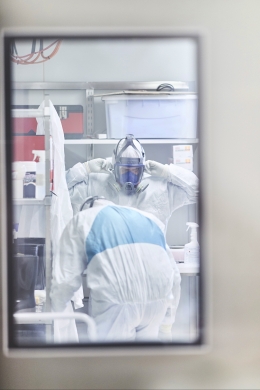
Kirby Institute researchers preparing to enter the PC3 containment lab, where our teams are working to grow the SARS-CoV-2 virus and determine how it responds to different treatments. Image: Richard Freeman / UNSW.
PC3 labs are among the most secure labs in Australia: they are specifically designed to keep infectious contagions from escaping.
“Any work on the live virus needs to happen in PC3 labs,” says Dr Sacha Stelzer-Braid, a postdoctoral scientist at UNSW Medicine.
“Before entering the lab, we go through a stringent dressing process. It takes a long time to get in the appropriate protective gear.”
They start by wearing what most would wear to the gym, shorts and a t-shirt, with a set of scrubs on over the top. Once this is on, they can move into the clean anteroom – the first of three chambers leading to the lab.
“Each chamber has a higher negative pressure that the one before it,” says A/Prof Turville. “This creates a vacuum that sucks air inwards, making it near impossible for any virus particles to escape.”
The first chamber is -25 kilopascals (kPa). As soon as the scientists enter, the fans ramp up and the pressure drops even more, only returning to -25 kPa once the door closes again. No two doors can be open at the same time.
Once in the anteroom, the staff put on layers of personal protective equipment (PPE).
“First we put on the gloves, then we remove our shoes and put protective booties over our socks, then we step into full-body suit with a hooded mask,” says A/Prof Turville.
“It’s very hot and claustrophobic,” he says. “It basically feels like putting on a bunch of garbage bags.”
“It’s very hot and claustrophobic,” he says. “It basically feels like putting on a bunch of garbage bags.”
From there they enter the main central lab – a clean designated area to put their P3 respirators on. These respirators seal off the face and connect to the hood, allowing them to breathe safely. This room has a lower pressure of -50 kPa.
Before stepping into the final module, the researchers then need to put on their gumboots and overalls.
“These water-resistant covers ensure that if anything spills on us, it will run to the floor and can be bleached,” says A/Prof Turville.
All direct work with the virus happens in the smallest chamber. At -75 kilopascals, this room has the highest negative pressure in the whole lab.
The first thing the researchers do in this lab is prepare for the worst.
“Before we start any work, we need to make up a whole bunch of decontaminating solution,” says A/Prof Turville. “Bleach, detergents, ethanol – we need to be prepared so that if anything happens, we’re ready to clean the spill.”
Finally, they are ready to start work on the live virus, which sits in a biosafety cabinet. The cabinet offers another layer of protection between the scientist and the virus.
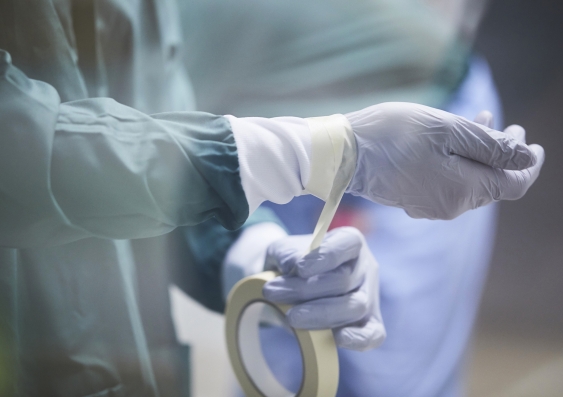
Kirby Institute researchers preparing to enter the PC3 containment lab, where our teams are working to grow the SARS-CoV-2 virus and determine how it responds to different treatments. Image: Richard Freeman / UNSW.
Working with and without the virus
Despite the lengthy process to get in the lab, A/Prof Turville’s team will generally only want to do work in there for an hour or two.
“Not only is the gear hot and uncomfortable, it’s also hard to communicate with each other,” says A/Prof Turville. “It’s like talking underwater.”
To make the most of the limited time in the lab, the researchers do as much preparation outside the lab as possible. Another part of the facility holds a lower-security lab.
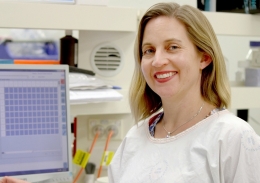
A lot of the work needs to happen outside the PC3 lab, says virologist Dr Sacha Stelzer-Braid. Image: Supplied.
“Before going in, we’ll manipulate the cells that aren’t infected, we’ll prepare the media – we’ll prepare absolutely everything,” says Dr Stelzer-Braid.
There’s also a lot of non-lab work needed to make the research possible
“When I’m not in the lab, I’ll be writing grants to get more funding for research, or writing research papers,” she says.
“Fighting this virus is a collaborative effort. We want to share our early findings more broadly.”
Making sure nothing gets in or out
The process of leaving the module is just as arduous as entering – if not more.
In the central chamber, there is a station where the scientists wipe the P3 respirator with alcohol before removing it. They hang it up to desiccate, so the alcohol and desiccation kills the virus.
Any material that touched the virus is also chemically decontaminated, sealed off and destroyed.
“There’s no way that the virus could escape the facility,” says A/Prof Turville. “It’s very stringently managed.”
The people who work in the lab are also routinely tested for the virus.
“To make sure no one catches the virus in the real world and shut down the research, we have a tag-team case scenario with three sets of highly trained teams.
“If one of them gets sick, we will rotate the teams and bring a new team online.”
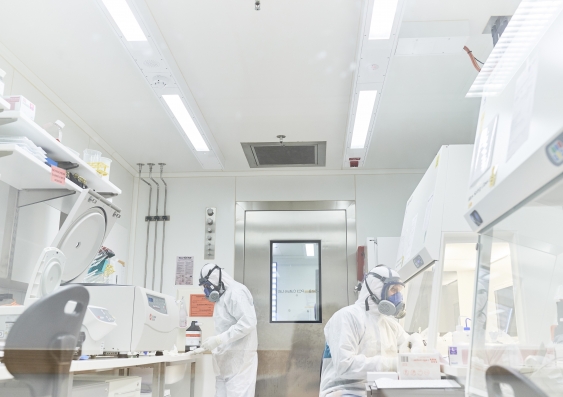
Stuart Turville and Alberto Ospina Stella in the Kirby Institute’s PC3 containment lab where they are working to grow the SARS-CoV-2 virus and determine how it responds to different treatments. Image: Richard Freeman / UNSW.
A race against time
The teams that have come together are working around the clock to fight against COVID-19.
“Our collaboration with Kirby has been amazing – everyone’s been very cooperative and collaborative in getting the lab to the stage where we can work with SARS-CoV-2,” says Dr Stelzer-Braid.
“A lot of people are working on this and everyone’s working really, really hard. I hope that people find comfort in that.”
“A lot of people are working on this and everyone’s working really, really hard. I hope that people find comfort in that.”
A/Prof Turville is determined to work as quickly as they possibly can.
“With other viruses that we work on, like HIV, our freezers are already filled with the materials we need for our lab work – virus samples, reagents and drugs,” he says.
“SARS-CoV-2 is completely different. Whenever we discuss timelines in our meetings, it’s always – we needed that therapy yesterday, or last week. We needed the experiment a month ago.
“We’re working as fast as we possibly can to make something that can help keep the people in intensive care units alive.”




